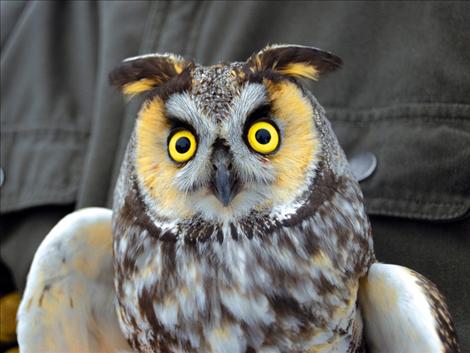Long-eared owl numbers down
Hey savvy news reader! Thanks for choosing local.
You are now reading
1 of 3 free articles.
POLSON — Owl expert Denver Holt entertained and informed Mission Valley Audubon Club members at their meeting on Dec. 11, sharing with audience members various observations he and his team have made about the creatures over the years.
Holt, who started the Owl Research Institute in the Ninepipe area, has researched long-eared owls for 28 years. The study areas are in the Missoula Valley, Ninepipe and Pablo.
ORI also has been studying snowy owls and prey species since 1992.
In a quick fact run-down, Holt said over the years ORI had banded 1,750 long-eared owls, including 610 chicks; found 235 nests and 25 major breeding and winter roost areas; and recorded 105 owls that show site fidelity — meaning the owls will return to the same nests year after year.
“If they nest in your yard, probably another bird will nest there next year,” Holt said.
Holt joked that he has a license to “harass wildlife for a living.”
So what are they learning with this harassment?
Holt learned that breeding season is more stressful for long-eared owls than cold Montana winters.
Think about yourself, Holt said. When the kids left the “nest,” it was quiet and sad — but it was quiet.
Long-eared owl breeding season starts in the wintertime, so Holt and his crew are out and about scouting the vegetation. The owls prefer thick vegetation to live in, and they forage out in open country.
Over the years, they’ve noticed long-ears roost communally. Holt and his researchers wondered about the composition of those groups. Were they relatives? Were they all male or all female? What age were they?
So they decided to band the family groups to start.
After banding and observation, Holt said they found that the groups are male and female, young and old and not necessarily relatives.
“One of the things that came out of it,” Holt said, “is there’s some sex going on in there.” When nesting season starts, some of the communal nesters pair off and find a place for their chicks.
Long-ear owls nest in abandoned magpie nests or sometimes raven or crow nests. In all owl species, Holt said the females incubate the eggs and feed the chicks in the nest. They develop a “brood patch,” where the feathers fall off and it’s skin to egg so they can apply direct heat to the eggs.
When the chicks hatch, they are covered with fuzzy white down. They grow rapidly, their white down turns charcoal gray and they leave the nest at three weeks, Holt said. The chicks leave the nest in the order they hatched and wander, climbing trees since they can’t fly yet. “They’re good climbers,” Holt explained. They’re dependent on their parents for food, and they probably grow as fast as they can due to predation from raccoons or even great horned owls.
Owls don’t hang about the nest for long since snowy owl chicks leave the nest at about three weeks, and short-eared owls at two weeks.
As for what long-eared owls eat, Holt said they’ve done 30,000 prey studies, i.e. dissecting owl pellets, and 90 percent of their food is voles.
“Voles make the world go round,” Holt explained.
When the vole population is high, owls, hawks and even ground nesting birds flourish because the predators focus on voles, the “Snickers” of the rangeland.
Ranchers are pleased that long-ears eat voles, according to Holt; he said ranchers tell him
“They can eat as many voles as they want.”
Male and female long-eared owls have different coloration. Holt and his researchers have pioneered a way to tell females from males by
using Munsell soil color charts and comparing the coloration of the owls’ facial disks, underwings and bars on the birds’ backs.
“Using this method we correctly scored 94 of 96 long-eared owls during the breeding season. That’s a pretty good number,” Holt said.
However, even with “all this really great habitat,” Holt said in the last 40 years, there’s been an 80 percent decline in short-eared owls. The population of long-eared owls is down to 6,000.
Populations fluctuate, Holt said, but the ORI has done the only long-term study of long-eared owls, and the trend for them is down.
What can be done?
“You’ve gotta bark a lot,” Holt said, adding that he will have to take the next step and provide date so the message can get out to the public.
For more information, go to owlinstitute.org.



















